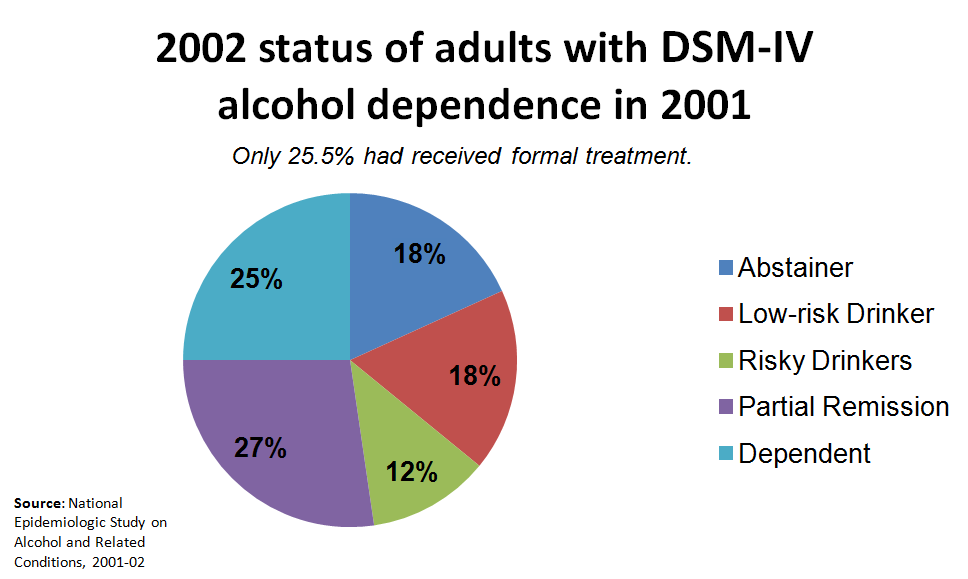
Expanding the definition of recovery during National Recovery Month
Given that September is SAMHSA’s National Recovery Month, I would like to speak about a recent realization: the reason this month is so important is that we have forgotten that recovery from addiction issues was and is the norm! For too long, our culture and language have described these issues as nearly impossible to tackle. We even have slogans like “once an addict, always an addict.” However, the evidence paints a different picture.
On the science front, we now have epidemiological data that describes alcohol dependence not as definitively progressive and fatal. Instead, it exists more on a continuum. The National Epidemiological Survey on Alcohol and Related Conditions (NESARC) conducted by the NIAAA revealed some very interesting data. In 2002, this study “examined people who met the criteria for DSM–IV alcohol dependence prior to the year immediately preceding.” Of the group, only 25% still met the criteria. Of the 75% who did not, 27.3% were in partial remission, 11.8% were risky drinkers, 17.7% were low-risk drinkers and 18.2% were abstainers. Even more amazing is that only 25.5% of all respondents had received formal treatment.
We can see that not everyone who escapes dependence does so through initial abstinence. Harm reduction pioneers, such as Alan Marlatt, Patt Denning, and Andrew Tatarsky, have long held the position that people can gradually flow through the continuum of use. A gradual spiraling upward. This idea opens up many options for working with clients who are in active addiction.
The first group of people who can really benefit from these ideas are those on medication-assisted treatment. Many in the abstinence-based recovery movement do not accept the idea that people on methadone or suboxone are in recovery. Instead, they believe that a person can only start their recovery once weaned off of the opioids and become abstinent. However, to use a phrase from HAMS Harm Reduction Network, “Better is Better.” Those who are working to make better lives for themselves deserve their work to be recognized as recovery.
And considering that only 25.5% of NESARC respondents reported undergoing formal treatment, we can also see a pattern of natural recovery, or “maturing out.” Now understand: I am in no way saying that we should stop treating or helping people. What I am saying is that this too is a form of recovery worthy of focus. Understanding the processes, values, and ideas of natural recovery can help us craft ways of intervening with people who are having a hard time helping themselves.
Among both the natural recovery and medication-assisted treatment populations, we can see that recovery is not simply abstaining from drug use (AKA “white knuckling” or being a “dry drunk”). A better definition of recovery is “the action or process of regaining possession or control of something stolen or lost.” Recovery is an action. It is a process. It has trips, slips and falls along the way. But it is, in the words of the great Stan Lee, “Excelsior!” Ever upward.
For too long, our culture and language have described these issues as nearly impossible to tackle.
Note that no self-help group or treatment option is focused on simply on abstinence. 12-Step has its foundation built on a spiritual awakening. SMART Recovery and HAMS have a focus on building lifestyle balance and working on emotional control. Community Reinforcement programs found in Therapeutic Communities base their transformation on interpersonal involvement. There is always a movement toward living a “good life.”
During Recovery Month, SAMHSA calls on practitioners, researchers, and those in recovery “to help expand and improve the availability of effective prevention, treatment, and recovery services for those in need.” So let us endeavor to do just that. Expand our options, expand our treatments, and expand our ideas of positive outcomes.
And, again per SAMHSA, Recovery Month is designed to “promote the message that recovery in all its forms is possible.”
Here, I’ll raise SAMHSA one: let’s promote the message that recovery, in its many forms, is normal, attainable and not just possible, but probable.
Kevin Gallagher is a homeless outreach counselor and graduate student in Clinical-Community Psychology at Point Park University. He runs an open meeting of SMART Recovery every Wednesday at the Wellspring Drop-In Center in Uptown Pittsburgh. Wellspring Drop-In Center is part of Mercy Community Health, Pittsburgh Mercy Health System, and CHE Trinity Health, serving in the tradition of the Sisters of Mercy.
Recommended Resources
- Official National Recovery Month website
- The Tricky Business of Defining Addiction Recovery, Inside Rehab author Anne Fletcher (2014)
- Guess What? Harm Reduction is a Common Path to Abstinence from Alcohol, HAMS Founder Kenneth Anderson (2014)
- Is Addiction Always Permanent? Mark Willenbring, MD (2014)
- Review of Quitting Drugs: Quantitative and Qualitative Features, Drug and Alcohol Findings (2013)






